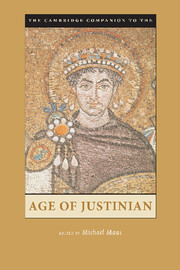Book contents
- Frontmatter
- Part 1 Structures and Ideologies of Empire
- Part 2 Religion and Philosophy
- Part 3 Literature and the Arts
- Part 4 Peoples and Communities
- 16 Jews in the Age of Justinian
- 17 The Age of Justinian
- 18 Justinian and the Barbarian Kingdoms
- 19 Byzantium and the East in the Sixth Century
- 20 The Background to Islam
- Bibliography
- Index
- Plate Section 1
- Plate Section 2
20 - The Background to Islam
from Part 4 - Peoples and Communities
Published online by Cambridge University Press: 28 May 2006
- Frontmatter
- Part 1 Structures and Ideologies of Empire
- Part 2 Religion and Philosophy
- Part 3 Literature and the Arts
- Part 4 Peoples and Communities
- 16 Jews in the Age of Justinian
- 17 The Age of Justinian
- 18 Justinian and the Barbarian Kingdoms
- 19 Byzantium and the East in the Sixth Century
- 20 The Background to Islam
- Bibliography
- Index
- Plate Section 1
- Plate Section 2
Summary
Muhammad, the prophet of Islam (d. 632 CE), who was born around the time of Justinian’s death in 565, is associated with changes that heralded the arrival of a new world unimaginable when Justinian was on the throne, and which we associate with the rise of Islam itself during the seventh century. Some of these changes, of course, must be attributed to distinctive features of Muhammad’s teachings, which, in turn, were shaped in part by his own unique character and life experiences (and, believing Muslims would insist, by the revelations God vouchsafed to him). Yet in a number of ways, it makes sense to try to see the rise of Islam in the context of social and intellectual developments in the late antique world. For no matter how original or unheralded Muhammad’s ideas and message may have been, his own outlook and understanding were inevitably shaped in part by the historical situation in which he lived. Likewise, the reception of Muhammad’s message by those around him would have been shaped by the concepts they had been exposed to in their lives. In both cases, this historical context derived from the institutions and ideas that prevailed in the immediately preceding generation - the Age of Justinian.
Problems of Perception
Attaining a clear historical view of the beginnings of Islam in historical perspective, however, has never been easy. Indeed, it is fair to say that despite the many “historical” works written about Islam’s beginnings, we still do not have a very good idea of what the movement begun by Muhammad was all about, and how it fit into the historical context of the late antique Near Eastern world.
- Type
- Chapter
- Information
- The Cambridge Companion to the Age of Justinian , pp. 510 - 534Publisher: Cambridge University PressPrint publication year: 2005
- 2
- Cited by

